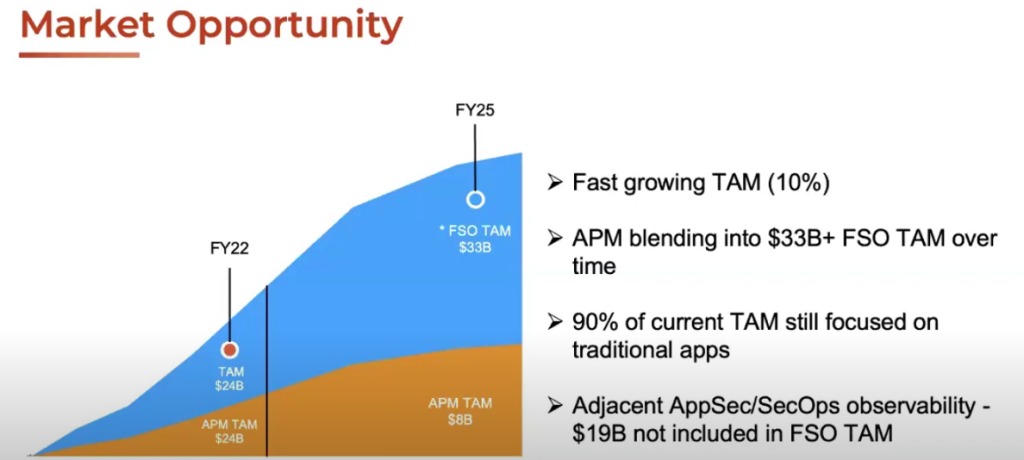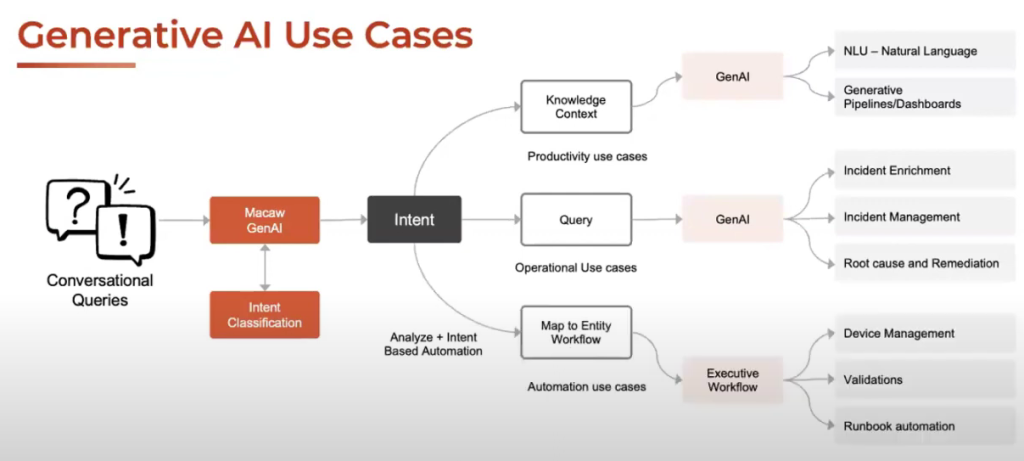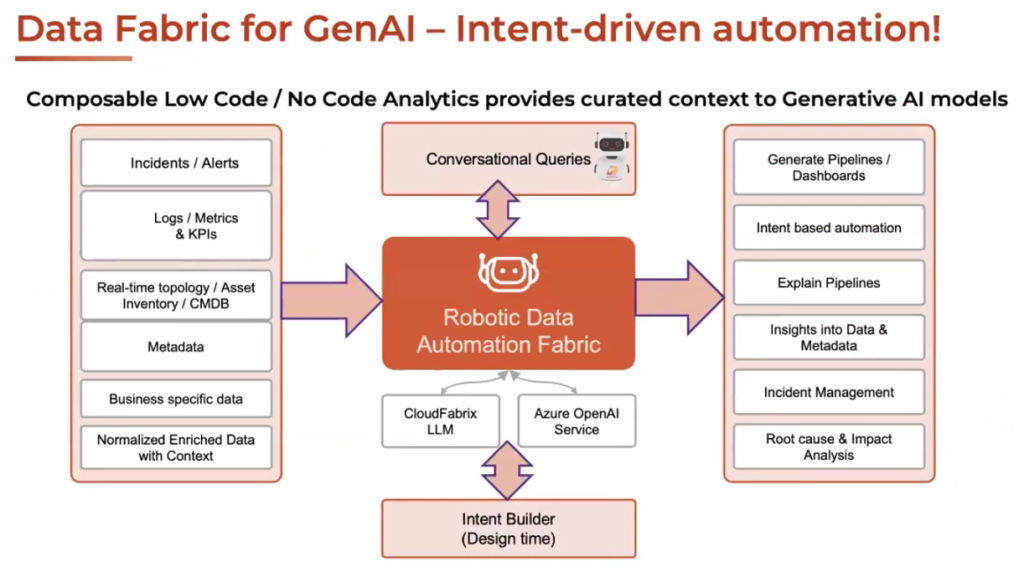CloudFabrix’s Macaw Conference for Observability and AIOps garnered traction and showcased modern solutions to modern IT problems in enterprises. This is a summary of the conference.
CloudFabrix CMO – Shailesh Manjrekar kicked off the conference by delivering the keynote by talking about the General Market Trends & highlighting the Modern IT challenges faced by Enterprises during their Digital Transformation journey.
As quoted by Shailesh during the conference “Customers today place greater emphasis on experience so that CX decides which businesses soar higher and which get left behind. Unfortunately, CX depends on the health of your IT infrastructure. Fortunately, modern AIOps and Data Fabric solutions have got you covered.”
Let’s dive in deeper to know about how enterprises can fill their gaps using Data Fabric & converge all the data from multiple platforms to gather some valuable insights.
The Modern IT Challenges
- Tool sprawl and siloes: It’s like searching for a needle in a haystack when your IT infrastructure is littered with too many domain-specific tools.
- Inability to predict and prevent issues: In a disintegrated IT infrastructure, IT operations teams can’t look beyond the immediate reality. This means a lack of predictive and preventative ITOps.
- Noisy data: Too many tools produce too much noise. Without data fabric, it’s hard to segregate the signal from the noise. So, even when you have a lot of data, it’s inconsequential.
- No business context: When data doesn’t come together to support business outcomes, it hinders progress. You never know what to prioritize as teams are involved in day-to-day fire extinguishing.
- Skillset gap: As the IT environment modernizes, democratizing operations is critical so that a citizen developer can clean and resolve issues. This means not all operations persons have to know Python and Java, which frees them up to closely monitor and predict IT issues.
Can your IT and Business Come Together?
Enterprise IT teams grapple with various issues across the distributed and multi-cloud landscape with applications, edge sites, public clouds, data centers, and security tools. They are overwhelmed with a deluge of data, struggle to consolidate data siloes, get caught up in false alarms and struggle to stay on top of operations.
On the other hand, the business exceedingly demands real-time visibility, automated operations, security resilience, customer experience, and accelerated AI-assisted decision-making.
How can you bring IT operations to support business outcomes?
Domain-specific tools cease to be useful as they can’t provide a holistic picture of a business’s internal IT infrastructure. Data is everywhere but of little use when it can’t lead to actionable insights.
This is where we move forward with modernization, democratization and innovation.
Modernizing IT Operations with AI –
The consequences of your IT’s health spread far and wide. Thus, the industry is moving fast to adopt the following modern solutions.
Data Convergence – Data needs to form a single source of truth to challenge the data-value gap. This means consolidating data across data lakes, data warehouses and other siloed sources.
Applied Observability – Gartner says that by 2026, 70% of organizations applying observability will make decisions faster and enable competitive advantage for the business and IT processes. Applied Observability allows using observable data in an integrated and strategized way across business functions, applications, infrastructure, and operations teams.
Intent-based Automation – Intent-driven automation with GenAI helps accomplish tasks such as asset tracking, maintenance, ticket assignment, device onboarding, and others in a conversational and assisted manner. Robotic Data Automation Fabric brings all three components together. So, we call it Data Fabric for observability, AIOps and GenAI.
The Massive Market Opportunity and Gap – Application Performance Monitoring is slowly fading out as Full Stack Observability gains its deserved Total Addressable Market share. The market has a massive untapped opportunity as 90% of the current TAM still focuses on traditional monitoring- a trend that will shift rapidly.

Note: AppSec and SecOps observability markets, which represent huge opportunities on their own, are not included in the diagram.
Applied Observability – Gartner introduced Applied Observability as “clarity instead of creativity” in how enterprises arrive at decisions using data. Applied observability starts by making data contextual and democratized before using AI/ML technologies to analyze decision-making and make future recommendations. In Gartner’s words, “Observability is not a forecast or prediction but rather a truly evidence-based source of decision making.”
Applied observability is being widely practiced to collect data, categorize it and derive insights from the behavior and performance of systems in a complex IT environment, typically including business applications, IT networks, cloud infrastructure, etc.
Traditionally, data access was confined to the IT operations and security teams. Today, organizations want to democratize access so that decision-making can happen in parallel at various levels using data-driven insights. Applied observability will help achieve data democratization while dissolving siloes.
AI for IT Operations – AIOps – AIOps serves today’s complex IT environment with distributed and perimeter-less architectures. AIOps is a new and the only way for modern enterprises to stay compliant, secure, available and resilient.

It uses data analytics, AI/ML, and big data functionality to collect and aggregate data from multiple sources, filter out noise to surface patterns, and diagnose root causes to automate remediation or escalate issues to ITOps teams.
CloudFabrix Data-centric AIOps is a domain-agnostic AIOps platform that supports event correlation and incident management.
A few AIOps use cases-
Event intelligence – CloudFabrix offers event intelligence out of the box. We connect disparate data sources across the IT, business and application layers and run AI/ML/AutoML functions. Consequently, CloudFabrix AIOps leads to 90% noise reduction, a 50% improvement in MTTI and MTTR, higher asset visibility, a single source of truth, and 100% lower compliance risks.
FinOps – Our FinOps capability offers cloud chargeback and optimization besides on-premise functionality. This way, organizations can democratize computing resources sans the risk of unnecessary spending. FinOps allows you to strengthen collaboration between engineering, finance and business departments.
Visibility-as-a-service – Visibility-as-a-service is looking at data across disparate sources and formats in a network and consolidating it into a single pane of glass. Network visibility is crucial to ensuring performance and security. So, it’s important to maintain visibility even when workloads transit to the cloud.
Generative AI
Generative AI capabilities disintegrate operational siloes and democratize IT operations. Teams in an organization can now converse with their data in their known language. This means your team does not need to be fluent in Java/Python to glean insights from data or generate solutions.
CloudFabrix Robotic Data Automation Fabric is now a no-code platform so that anyone in a customer organization can use conversational queries to work the data through the data fabric.

Generative AI has been a key piece to democratize the Ops landscape. Here are a few examples of prompts/queries our customers feed into their GenAI implementation-
- Please create data pipelines for this specific application.
- Can you create a dashboard for me that summarizes incidents and solutions?
- Please explain the root cause behind this incident.
- Can you summarize all critical incidents this month?
- Please remediate this nature of IT issues automatically.
Think of GenAI capability as Google for operational issues.
The Data Fabric for Observability, AIOps and GenAI
Data Fabric is the glue that holds these capabilities together. Most prominently, it uses customer data to build customized context and knowledge through a Large Language Model (LLM). Without this custom LLM, you’d be using generic GenAI trained on OpenAI or internet-based datasets, which would be of little use to your enterprise-specific data and applications.
Let’s see how Robotic Data Automation Fabric works.

Here, RDAF accepts incident alerts, MELTs, topology info, metadata, business-specific data, and normalized and enriched data. The data fabric generates context, which is used to train the local LLMs based on Llama 2. These LLMs are kept secure and private as they contain customers’ data.
We also use Azure OpenAI service, an enterprise-based solution. Then, the intent builder creates a precise prompt for the LLMs and enables users to ask conversational queries and generate outputs such as pipelines, insights, and so on.
Here are some additional highlights of the event:
Gregg Ostrowski and Cyrus A, Executive CTOs at Cisco AppDynamics, Arun Jayaraman, CTO at Tata Communications, and Shailesh Manjrekar, CMO at CloudFabrix, discussed vertical market trends in observability. Thought leaders discussed how businesses struggle with compliance issues, sprawling technology architecture, and legacy mainframe systems and still must adhere to what customers want. Observability solves the pains for businesses. Industries discussed include fintech, leisure & travel, the public sector, telecommunications, manufacturing, healthcare, and life sciences.
Carlos Pereira, Chief Architect at Cisco and Raju Penmetsa, Co-founder and CTO at CloudFabrix, talked about the latest developments and innovations in the Cisco FSO Platform and its Extensibility with partners like CloudFabrix. Carlos mentioned the Cisco AI Index, a survey of 8,000 Cisco customers across the globe that found 95% of the customers have an AI strategy, while less than 14% have an execution plan to put it into action. This points to the large gap in how organizations want to implement AI use cases but need help with implementation.
Venkat Raghava, Partner at IBM, Meenakshi Srinivasan, Partner of Global DevSecOps Practice at IBM Consulting, and Srinivas Miriyala, Global Product Marketing & APAC BD Head at CloudFabrix, discuss IBM’s vision around ICT-IBM Consulting Third Eye and its partnership with CloudFabrix for Asset Intelligence/FinOps, Telco and SAP use cases leveraging GenAI. The conversation included how AIOps implementation demands and warrants a cultural shift in an organization and what leaders can tell their teams to make them feel transformation is important and working.
Dan Turchin, CEO at PeopleReign and Shailesh Manjrekar, CMO at CloudFabrix, discuss GenAI trends in AIOps and Observability. Dan highlighted how operations transformation not only includes amassing data but introspecting patterns in data just as we consume knowledge and meet people by sorting through information. Similarly, GenAI can help unpack potential from data.
Venu, Director at Cisco and Shailesh Manjrekar, CMO at CloudFabrix, explore intent-based automation and how data, AI, and automation are used alongside GenAI to create an automation framework for major Telco industry use cases. Speakers covered operational data-centric use cases, including incident enrichment, syslog mnemonic code enrichment, predictive diagnostics recommendation, historical incident summarization and analysis and more.
Bhaskar Krishnamsetty, Co-founder and Chief Products Officer at CloudFabrix, shared the vision, architecture, and implementation of Macaw GenAI Assistant for observability, AIOps, and intent-based automation. The speaker highlighted how Macaw and GenAI can enable users to ask intelligent questions, analyze datasets and assess intent with AI for precise automation.
Tejo Prayaga, Sr. Director of Product at CloudFabrix, discussed CloudFabrix’s collaboration with partners on operational intelligence, log intelligence, and IT planning use cases. Partners include Atul Babu, Founder and CEO of Dhata Tech, Tushar, lead for automation technologies at DXC, Avinash Malik at Wipro, and Shrikanth from WWT.
Shailesh Manjrekar, CMO at CloudFabrix and Tejo Prayaga, Sr. Director of Product Management & Marketing at CloudFabrix, concluded the event by sharing their vision, roadmap, and execution plan for the next two years.
Thought leaders, industry experts, and peers unanimously supported the industry shift from monitoring, which only “keeps the lights on”, to observability and AIOps and Data Fabric that suit the modern enterprise and their customers’ needs better.
Applied observability, AIOps, and GenAI are making IT operations streamlined, automated, and cleaner than ever. This means better business outcomes for enterprises and data-led growth. Learn more about CloudFabrix Generative AI assistant here.





